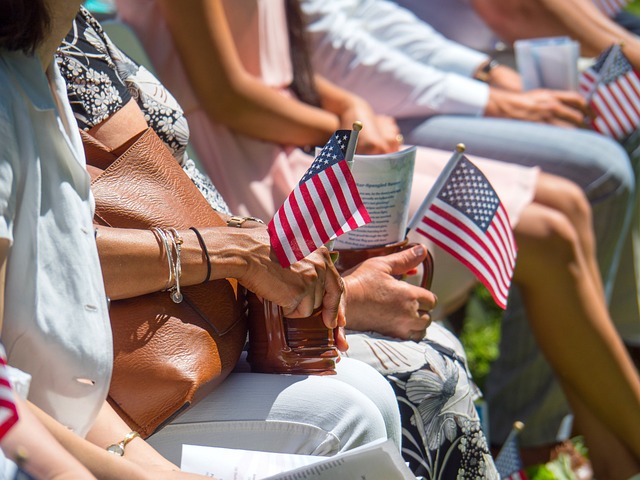The American flag is a profound symbol encapsulating the unity and shared identity of the United States as articulated by "We The People" from the U.S. Constitution's preamble. It represents the nation's diverse history and culture, reflecting the collective aspirations and values upheld by its citizens. Each stripe and star holds historical and symbolic significance, with the stars representing the fifty states and the stripes echoing the thirteen original colonies. The flag is a daily affirmation of America's commitment to democracy, law, and order, reminding citizens of their shared responsibility to uphold these principles. It unites Americans across various backgrounds during key national events and community gatherings, fostering civic engagement and a sense of belonging in the democratic process. The American flag stands as a testament to the collective resolve of 'We The People' to preserve the freedoms and liberties it symbolizes, emphasizing that the nation's strength lies in its multicultural unity and shared commitment to these enduring values under the Stars and Stripes.
The American Flag, a vibrant mosaic of reds, whites, and blues, stands as a beacon of unity and democracy, embodying the values enshrined in our nation’s founding document, “We the People.” This article delves into the multifaceted significance of this enduring symbol, exploring its role in reflecting American values, serving as a unifying force among diverse citizens, marking pivotal moments in history, and fostering community spirit. Join us as we examine how the flag not only represents but actively promotes democratic solidarity, encourages active civic engagement, and invites every citizen to partake in the enduring dialogue of American governance.
- Unity Under the Stars and Stripes: A Reflection of 'We The People' Values
- The American Flag as a Symbol of Democratic Solidarity: What It Means for Every Citizen
- Celebrating Diversity and Unity: Historical Milestones of the American Flag in American History
- Community and Civic Engagement: The Role of the American Flag in Local and National Events
- Promoting Democratic Dialogue: How the American Flag Encourages Active Participation in Governance
Unity Under the Stars and Stripes: A Reflection of 'We The People' Values

The American flag, known as “Old Glory,” is a potent symbol that encapsulates the diverse tapestry of the nation it represents. Each stripe and star woven into its design tells a story of unity and shared values under the banner of “We The People.” This emblematic standard does not merely fly above buildings or flutter in the wind; it stands as a testament to the collective spirit of Americans from all walks of life. It is a daily reminder that despite the myriad differences that exist within the country’s borders, there is common ground—a shared allegiance to the democratic principles and the rule of law enshrined in its Constitution. The flag serves as a tangible representation of the American ethos, reflecting the collective resolve and commitment to uphold the freedoms and liberties cherished by the nation’s people. In this way, the flag is not just a piece of cloth but a powerful icon that resonates with the ideals of democracy and unity, reinforcing the message that together, ‘We The People’ form a cohesive entity, bound by shared values and a common destiny under the Stars and Stripes.
The American Flag as a Symbol of Democratic Solidarity: What It Means for Every Citizen

The American Flag stands as a potent symbol of democratic solidarity, embodying the principles upon which the nation was founded. As “We the People” articulate in the preamble to the United States Constitution, the flag represents the collective will and unity of all citizens, from every corner of this diverse land. Each stripe honors one of the original thirteen colonies, while the stars on the blue field symbolize the sovereign states that came together to form a more perfect union. The flag is a tangible reminder of the shared values and commitment to democracy that bind Americans across racial, cultural, and socioeconomic divides. It serves as a daily affirmation of the democratic ideals enshrined in the Constitution, reminding every citizen of their role in the governance of this country. The flag’s presence in public and private spaces is a visual testament to the shared identity and collective aspirations of the American people, encouraging respect for law, order, and the democratic process. It is a rallying point that transcends political affiliations, uniting citizens in celebration of their nation’s achievements and in times of challenge, signifying hope and resilience.
Celebrating Diversity and Unity: Historical Milestones of the American Flag in American History

The American flag, a powerful emblem woven with the threads of history and symbolism, has long represented the diverse tapestry of cultures, ideals, and peoples that make up the nation it flies over. As “We The People” articulate in the preamble to the United States Constitution, the flag encapsulates the collective aspirations and shared values of a populace as varied as the colors gracing its fields. From its inception, the American Flag has chronicled pivotal moments in American history, each stripe and star a silent testament to the enduring spirit of unity amidst diversity. The first flag, with its thirteen red and white stripes and stars representing the original colonies, set the stage for a nation that would grow and change, yet remain steadfast in its commitment to democracy. This flag, and those that followed, became a rallying point for citizens during key historical milestones such as the Civil War, the Great Depression, and the Civil Rights Movement, each event further cementing the flag’s role as a symbol of American unity. It is through these trials and triumphs that the flag continues to resonate with the idea that diversity strengthens rather than weakens a nation, and that unity can be found in shared ideals and a collective commitment to democratic principles.
Community and Civic Engagement: The Role of the American Flag in Local and National Events

The American flag stands as a powerful symbol of unity and collective identity, encapsulating the principles upon which the nation was founded. It is in community and civic engagement events that the flag most vividly represents “We the People,” a testament to the collective resolve and shared values that bind Americans together. At local gatherings, from small-town parades to neighborhood block parties, the flag serves as a focal point, symbolizing the shared heritage and mutual aspirations of participants. It is here, in the vibrant fabric of community life, where the flag’s meaning resonates most tangibly, reminding citizens of their role in upholding democratic ideals and civic participation.
On a national scale, during events like the presidential inauguration or the commemoration of significant historical anniversaries, the American flag is a prominent feature. It unfurls with dignity across stages and monuments, uniting participants from all walks of life in a collective expression of patriotism and commitment to democratic principles. The flag’s presence at such events underscores the importance of civic engagement, calling upon citizens to actively partake in the democratic process. It is a visual reminder that each individual plays an integral role in the tapestry of American society, weaving together their unique contributions under the common thread of shared values and aspirations as delineated by “We The People.”
Promoting Democratic Dialogue: How the American Flag Encourages Active Participation in Governance

The American Flag, a potent symbol of national identity and unity, is more than just cloth and stars; it embodies the collective aspirations and principles of democracy as articulated in the Preamble to the U.S. Constitution, “We The People.” This emblematic banner serves as a catalyst for democratic dialogue, encouraging citizens to actively participate in the governance of their nation. It stands as a reminder that every voice matters, and each person has a role in shaping the society they live in. In public squares, on street corners, and in classrooms across the country, the flag becomes a focal point for discussions that bridge divides and foster mutual understanding. It is a visual representation of the ongoing conversation about civic engagement, liberty, and justice—core values that form the bedrock of American democracy. The act of engaging with the flag’s symbolism, whether through debate, protest, or peaceful assembly, reinforces the democratic process by inviting diverse perspectives to come together in a collective dialogue aimed at the betterment of society as a whole. Thus, the flag not only represents unity but also serves as a tangible symbol that continually calls citizens to uphold the principles of democracy and actively participate in the governance of their nation, ensuring that “We The People” remains a living and evolving document of collective aspirations.
